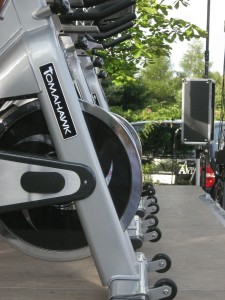The Magic of High Intensity Interval Training (HIIT)
High Intensity Interval Training (HIIT)
 HIIT training is another type of cardiovascular training and it’s the exact counter part to (slow long duration) SLD cardio. If you missed the blog post about SLD cardio you can read it here.
HIIT training is another type of cardiovascular training and it’s the exact counter part to (slow long duration) SLD cardio. If you missed the blog post about SLD cardio you can read it here.
The best way to describe a HIIT workout is to think of performing periods of high intensity work followed by a specified recovery time. This combination of work and rest intervals is highly effective for conditioning the cardiovascular system and for revving up your calorie burn.
The Benefits
In a 6 week study comparing 45-60 minute cardio sessions to HIIT workouts, the HIIT participants showed significantly higher oxidative enzymes in the mitochondria. Mitochondria is the energy factory of our cells where fat is turned into usable energy. HIIT also created a greater increase in the amount of blood pumped per beat as well as improved oxygen uptake (15% compared to 9%).
The real magic of HIIT is the post exercise calorie burn. The workout creates such an energy deficit that your body will increase the intake of oxygen (think extra calories burned) until the debt is paid. The higher the intensity the greater the debt and more calories are burned to help your body recover.
Before you run out there and start your HIIT workouts, check out these guidelines.
The Guidelines:
Follow these three steps to make sure your HIIT workouts are both safe and effective:
1. Build your cardio base first – Train with steady state cardio training for one to three months. This is the type of training where you work out at steady speed or resistance level for 20-60 minutes. Your body needs this type of training to prepare itself for the higher stress and effort required for HIIT workouts.
2. Pick a safe modality – Because you will be working at a very high intensity, choosing a safe vehicle in which to do so is paramount. I suggest starting with a stationary bike. It allows you to work at max levels without worrying about falling off equipment or stumbling while you’re running.
3. Use a heart rate monitor. – You’ll need a heart rate monitor to get the most out of this type training. An important part of HIIT is performing work at the recommended level of intensity (between 75-85%) of your max heart rate. You can’t stop your training to check your pulse manually but you still need an instant heart rate reading to make sure your balancing working hard enough without working too hard.
The Workout:
Remember it’s not how much time you spend doing the exercise, it’s the stimulus created and how many calories you burn when you’re done.
This program is ideal if you’re just getting started with HIIT and can also be scaled to higher fitness levels. All you need is stationary bike.
Here’s the program:
- Do this three times per week.
- Perform 4 to 10 intervals of 30 second maximal effort cycling. This is at 75-85% of max heart rate
- Follow each maximal effort interval with 4 minutes of recovery at 50-65% of max heart rat
It’s required that you give everything you have for thirty seconds to elicit the post exercise calorie burn.
Start with 4 intervals per session if you’re new, then you can increase by 1 more 30 second interval every week or two or when you feel your body is ready for it.
With HIIT sessions, you’ll become a metabolically efficient, fat burning machine and will spend less time doing it. The shorter length of time (20 minutes to start) lends itself to be an ideal choice during the work week when you have less time to work out.
When and how much you train depends on your fitness level and where you are with your fitness goals. Start at appropriate levels and don’t over do it at the start. If you apply HIIT workouts appropriately you’ll soon find yourself making progress towards your goals.
If you have any specific questions in how best to make cardio training work for you please contact me. I would love to hear from you.
Edward Scaduto
Move Well, Live Better


